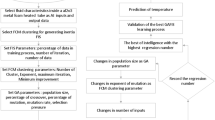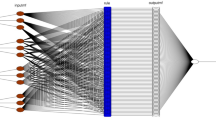Abstract
This paper reports the application of the adaptive neuro-fuzzy inference system to model the forced convection heat transfer from v-shaped plate internal surfaces exposed to an air impingement slot jet. The aim of the current study is to consider the effects of the angle of the v-shaped plate \( (\Upphi ) \), slot-to-plate spacing ratio (Z/W) and the Reynolds number (Re) variation on the average heat transfer from the v-shaped plate.











Similar content being viewed by others
Abbreviations
- L :
-
Plates width (m)
- W:
-
Nozzle width (m)
- Z :
-
Distance between nozzle exit and v-shaped plate forward stagnation point (m)
- h :
-
Local heat transfer coefficient (W/m2 K)
- \( \overline{h} \) :
-
Average heat transfer coefficient (W/m2 K)
- k :
-
Thermal conductivity (W/m K)
- Nu x :
-
Local Nusselt number
- \( \overline{Nu} \) :
-
Average Nusselt number
- Ra :
-
Rayleigh number based on the plate width
- Re :
-
Reynolds number based on the nozzle exit velocity and nozzle width
- T :
-
Temperature (K)
- \( \Upphi \) :
-
Angle between plates (°)
- f :
-
Film condition
- w :
-
Surface of the plates
- ∞:
-
Undisturbed air and ambient
References
Martin H (1977) Heat and mass transfer between impinging gas jets and solid surface. Adv Heat Transf 13:1–60
Jambunathan K, Lai E, Moss MA, Button BL (1992) A review of heat transfer data for single circular jet impingement. Int J Heat Fluid Flow 13:106–115
Viskanta R (1993) Heat transfer to impinging isothermal gas and flame jets. Exp Therm Fluid Sci 6:111–134
Thomann H (1968) Effect of streamwise wall curvature on heat transfer in a turbulent boundary layer. J Fluid Mech 33:283–292
Mayle RE, Blair MF, Kopper FC (1981) Turbulent boundary layer heat transfer on curved surfaces. J Heat Transf 101:521–525
Chupp RE, Helms HE, McFadden PW, Brown TR (1969) Evaluation of internal heat transfer coefficients for impingement cooled turbine airfoils. J Aircr 6:203–208
Metzger DE, Yamashita T, Jenkins CW (1969) Impingement cooling of concave surfaces with lines of circular air jets. J Eng Power 91:149–158
Tabakoff W, Clevenger W (1972) Gas turbine blade heat transfer augmentation by impingement of air jets having various configurations. J Eng Power 94:51–60
Dyban YP, Mazur AI (1970) Heat transfer from a flat air jet flowing into a concave surface. Heat Transf Sov Res 2:15–20
Metzger DE, Baltzer RT, Jenkins CW (1972) Impingement cooling performance in gas turbine airfoils including effects of leading edge sharpness. J Eng Power 94:219–225
Bunker RS, Metzger DE (1990) Local heat transfer in internally cooled turbine airfoil leading edge regions, part I-impingement cooling without film coolant extraction. ASME J Turbomach 112:451–458
Gau C, Chung CM (1991) Surface curvature effect on slot airjet impingement cooling flow and heat transfer process. J Heat Transf 113:858–864
Garimella SV, Nenaydykh B (1996) Nozzle-geometry effects in liquid jet impingement heat transfer. Int J Heat Mass Transf 39:2915–2923
Colucci DW, Viskanta R (1996) Effect of nozzle geometry on local convective heat transfer to a confined impinging air jet. Exp Therm Heat Fluid Sci 13:71–80
Yousefi T, Karami A, Rezaei E, Ebrahimi S (2012) Fuzzy modeling of the forced convection heat transfer from a v-shaped plate exposed to an air slot jet. Heat Transf Asian Res 41:430–443
Karami A, Rezaei E, Rahimi M, Khani S (2013) Modeling of heat transfer in an air cooler equipped with classic twisted tape inserts using adaptive neuro-fuzzy inference system. Chem Eng Comm 200:532–542
Hikmet E, Mustafa I, Abdulkadir S, Mehmet E (2008) Modelling a ground-coupled heat pump system using adaptive neuro-fuzzy inference systems. Int J Refrig 31:65–74
Karami A, Rezaei E, Shahhosseni M, Aghakhani M (2012) Fuzzy logic to predict the heat transfer in an air cooler equipped with different tube inserts. Int J Therm Sci 53:141–147
Rezaei E, Karami A, Yousefi T, Mahmoudinezhad S (2012) Modeling the free convection heat transfer in a partitioned cavity using ANFIS. Int Commun Heat Mass Transf 39:470–475
Ying LC, Pan MC (2009) Using adaptive network based fuzzy inference system to forecast regional electricity load. Energy Convers Manag 49:205–211
Ekici BB, Aksoy UT (2011) Prediction of building energy needs in early stage of design by using ANFIS. Expert Syst Appl 38:5352–5358
Ayata T, Çam E, Yıldız O (2007) Adaptive neuro-fuzzy inference systems (ANFIS) application to investigate potential use of natural ventilation in new building designs in Turkey. Energy Convers Manag 48:1472–1479
Mehrabi M, Pesteei SM, Pashaee TG (2011) Modeling of heat transfer and fluid flow characteristics of helicoidally double-pipe heat exchangers using adaptive neuro-fuzzy inference system (ANFIS). Int Commun Heat Mass Transf 38:525–532
Varol Y, Avci E, Koca A, Oztop HF (2007) Prediction of flow fields and temperature distributions due to natural convection in a triangular enclosure using adaptive-network-based fuzzy inference system (ANFIS) and artificial neural network (ANN). Int Commun Heat Mass Transf 34:887–896
Das MK, Kishor N (2009) Adaptive fuzzy model identification to predict the heat transfer coefficient in pool boiling of distilled water Expert Syst Appl 36:1142–1154
Karami A, Rezaei E, Mahmoudinezhad S, Yousefi T (2012) Optimization of a free convection heat transfer in a horizontal cylinder beneath an adiabatic ceiling using Imperialist competitive algorithm (ICA). J Chem Eng Jpn 45:401–407
Bever MB (1949) Encyclopedia of materials science and engineering, vol 7. Pergamon press, Oxford
Yousefi T, Karami A, Ghashghaei D, Veysi F (2012) An experimental investigation on the free convection heat transfer in a horizontal cavity consisting of flow diverters. Heat Transf Asian Res 41:553–564
Hauf W, Grigull U (1970) Optical methods in heat transfer, advances in heat transfer, vol 6. Academic Press, New York
Eckert EERG, Goldstein RJ (1972) Measurements in heat transfer, 2nd edn. McGraw-Hill, New York
Kline SJ, McClintock FA (1953) Describing experimental uncertainties in single sample experiments. J Mech Eng 75:3–8
Flack RD (1978) Mach–Zehnder interferometer errors resulting from test section misalignment. Appl Optic 17:985–987
Takagi T, Sugeno M (1985) Fuzzy identification of systems and its application to modeling and control. IEEE Trans Syst 15:116
Jang JSR, Sun CT (1995) Neuro-fuzzy modeling and control. Special issue on fuzzy logic in engineering applications. Proc IEEE 83:378–406
Jang JSR, Sun CT, Mizutani E (1997) Neuro-fuzzy and soft computing, vol 19. Prentice Hall, Englewood Cliffs
Karami A, Yousefi T, Rezaei E, Amiri A (2012) Modeling of the free convection heat transfer from an isothermal horizontal cylinder in a vertical channel via the fuzzy logic. Int J Multiphys 6:7–16
Aghakhani M, Mahdipour Jalilian M, Karami A (2012) Prediction of Weld Bead dilution in GMAW process using fuzzy logic. Appl Mech Mater 110:3171–3175
Amiri A, Karami A, Yousefi T, Zanjani M (2012) Artificial neural network to predict the natural convection from vertical and inclined arrays of horizontal cylinders. Polish J Chem Technol 14:46–52
Karami A, Rezaei E, Rahimi M, Zanjani M (2012) Artificial neural modeling of the heat transfer in an air cooled heat exchanger equipped with butterfly inserts. Int Energy J 13:21–28
The MathWorks (1995–2007) fuzzy logic toolbox user’s guide. Inc., 3 Apple Hill Drive, Natick
Pedrycz W (1994) Why triangular membership functions? Fuzzy Sets Syst 64:21–30
Author information
Authors and Affiliations
Corresponding author
Rights and permissions
About this article
Cite this article
Karami, A., Yousefi, T., Ebrahimi, S. et al. Adaptive neuro-fuzzy inference system (ANFIS) to predict the forced convection heat transfer from a v-shaped plate. Heat Mass Transfer 49, 789–798 (2013). https://doi.org/10.1007/s00231-013-1125-z
Received:
Accepted:
Published:
Issue Date:
DOI: https://doi.org/10.1007/s00231-013-1125-z




